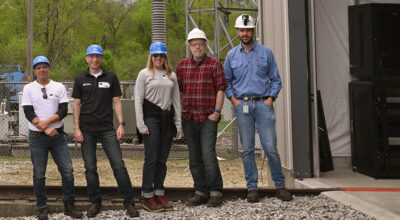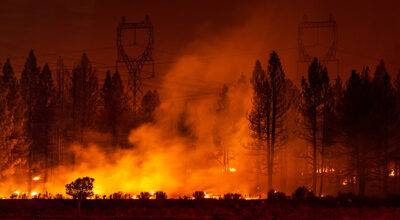Although renewable energy sources are rapidly expanding, fossil fuels like oil, natural gas and coal still comprise more than 80% of the world’s primary energy consumption. Transporting these energy sources from their origins to where they’re needed is one of the planet’s most complex logistical challenges.
According to Global Energy Monitor, there are 315,411 kilometers of operational oil and gas pipelines in the world today. That’s enough to circle Earth eight times. Shut down even one of these, and the economic consequences can be dire – as we saw in the recent Colonial Pipeline shutdown, which resulted from a cyberattack, and are currently seeing with the Nord Stream 2 pipeline closure.
Oil & gas pipelines, which form the backbone of modern energy systems, are highly-complex physical infrastructure assets. And just like any critical infrastructure, they require close monitoring, tight security and strict ongoing maintenance. But unlike an oil-fired electrical power production facility for example, the geographic scale on which pipelines operate is so incredibly distributed, that even understanding precisely where a problem exists is a challenge.
So, here are the top three monitoring challenges pipeline operators currently face, and possible solutions:
Challenge 1 – Theft… AKA Hot-Tapping
As energy prices continue to rise, theft from oil & gas pipelines is increasingly prevalent. In Nigeria, one of the developing world’s major oil producers, an estimated 250,000 barrels of crude oil per day are stolen from pipelines. In Mexico, authorities have reported an incredible 944% rise in cases of oil theft since 2021 – with nearly 3200 illicit pipeline taps discovered. What’s more, oil theft is becoming increasingly sophisticated and organized. Illegal hot tapping, the creation of a branch line to divert flow from a pipeline, is becoming more common, yet remains difficult to detect.
What Can be Done? The good news is that theft by tapping or hot tapping a pipeline is noisy. Thieves need to dig, drill, or weld – usually in remote areas where nobody sees. Through efficient pipeline monitoring, this mechanical work is easily detectable with the right fiber optic sensing detection tools in place.
Challenge 2 – False and Nuisance Alarms
While the capital expenses of building a pipeline are great, the costs of pipeline operation are even greater. And maintenance makes up the lion’s share of these operational expenses (OpEx). To streamline pipeline OpEx, pipeline operators need to ensure that maintenance is highly-efficient and crew dispatch to remote locations is justified. Crews sent into the field to handle false alarms can waste scarce resources and leave actual faults unaddressed.
What Can be Done? Advanced machine learning-driven monitoring solutions dramatically lower false alarm rates (FAR) by closely analyzing alerts to filter out false positives and nuisance alarms. This means your field teams can focus on important tasks, without wasting their time chasing problems that do not exist and your pipelines suffer from much less downtime and can be run optimally.
Challenge 3 – Leaks
In the US alone, large pipeline leaks cost $7.7 billion from 2005-2020, according to the US Pipeline and Hazardous Materials Safety Administration (PHMSA). A major new pipeline leak is reported to the US government every 40 hours – and minor leaks can go undetected and unrepaired for years. For example, last year a leak in an underwater oil pipeline near Huntington Beach, California spilled tens of thousands of gallons of crude with devastating ecological and economic impacts on that community and its surroundings. Yet the leak was caused by incidents that occurred months previously, but were never detected, according to the US Coast Guard, highlighting the need for efficient oil pipeline monitoring solutions.
What Can be Done? When pipeline monitoring falls short, results can be disastrous. To lower regulatory and public pressure, midstream operations need to adopt readily-available, advanced fiber optic sensing technology such as PrismaFlow to safeguard the environment, operations and their brand.
Today’s Solutions Fall Short
To monitor oil and gas pipeline leakage, midstream operators have turned to various pipeline monitoring technologies and solutions. From IoT to satellite to drone-based systems – these solutions are not only costly to purchase, they are also highly complex and time-consuming to rollout, as well as being resource-intensive to operate. Most importantly, these solutions do not scale to the size and span of the pipeline network which may also cover very harsh territories to operate.
The reason? Existing pipeline monitoring systems rely on attaching physical sensors to the pipeline. This paradigm is inherently unscalable, because it relies on manual placement – digging, unearthing the pipeline (a highly-dangerous practice that demands special equipment and expertise), and placing tens of thousands of sensors.
Other monitoring solutions rely on monitoring only in valve stations, which are often geographically distributed. This means that problems are detected only at a low resolution – leaving crews to cover vast sections of pipeline to identify a potential problem – and frequently leaving small leaks undetected. Drone and other visual inspections can cover up to a certain distance and it takes a long time to cover an entire pipeline so deterioration can happen between visits.
To meet operational, ecological, regulatory, and public expectations – a new pipeline monitoring paradigm is required.
Prisma Photonics Can Help
PrismaFlow from Prisma Photonics enables midstream operators to instantly monitor thousands of kilometers of transmission pipelines for leaks and theft accurately and in real-time – without installing any additional sensors.
PrismaFlow leverages the existing optical fiber network deployed with transmission pipelines – turning these into a set of highly sensitive distributed sensors that identify leaks, digging, third-party intrusion, and pig activity. PrismaFlow is effective on installation day – lowering monitoring costs and offering an innovative pay-as-you-grow service model, as well as a more traditional ownership model.
The Bottom Line
Pipelines are the backbone of modern energy systems. These complex and massive physical infrastructure assets that require close monitoring to ensure optimal and safe operation. Pipeline monitoring is key to a better, safer, cleaner, and cheaper energy future. Yet even as the scale of pipelines grows, existing monitoring solutions rely on legacy monitoring methods and technology – leaving midstream operators exposed to theft, leakage and regulatory liability.
Today, advanced solutions like PrismaFlow leverage fiber optics already built-in to pipeline infrastructure, alongside powerful machine learning, to deliver a more comprehensive, more accurate, and more cost effective solution – solving this critical problem for critical energy infrastructure.
Click here to learn more about how PrismaFlow can help your pipeline monitoring!






